Just east of Marienplatz is the famous landmark that features on most of Munich’s postcards: the Frauenkirche, the city’s cathedral, officially known as the « Dom zu unserer lieben Frau » (Cathedral of Our beloved Lady).
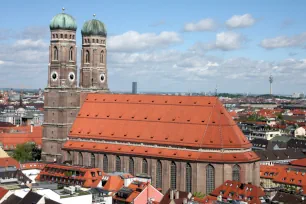
The foundation stone of the cathedral was laid by Duke Sigismund in 1468. The building replaced an earlier church from the thirteenth century. Not only was this church in need of repairs, it was also deemed too small for the increasing importance of the church.
The Building
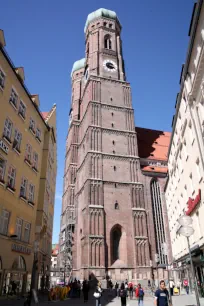
The large Gothic building was constructed in a record time of just twenty years. The red brick church was built under the direction of the German architect Jörg von Halsbach who after his dead in 1488 was succeeded by Lucas Rottaler.
The triple-naved cathedral is one hundred and nine meters long and forty meters wide (358 x 131 feet). The two towers reach a height of ninety-nine meters (325 feet). The monumental building still towers over the city of Munich. By law, no new building is allowed to obstruct the view of the cathedral.
The building was severely damaged at the end of the Second World War, when the roof partially collapsed as a result of an allied bombardment. After the war, the cathedral was restored in several phases; the first phase was completed in 1953, but it would take until 1994 before the church was fully restored.
The Domes
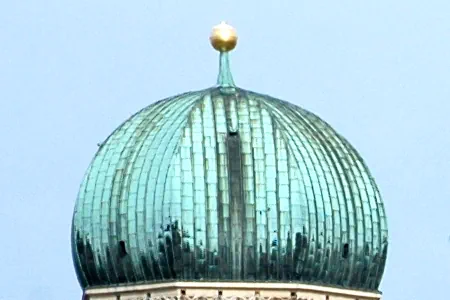
Due to a shortage of funds, the initially planned spires which would top the twin towers were not built. In 1525, several decades after the church was completed, it was decided to cover the towers with onion-shaped domes. The design of the octagonal domes – which would later be copied by many churches in Bavaria – was inspired by the Dome of the Rock in Jerusalem. The architects modeled the domes after an illustration found in the book ‘Peregrinatio in Terram Sanctam’ by Bernhard von Breydenbach. This book, a sort of ‘travel guide’ for pilgrims, was very popular at the end of the fifteenth century.
Interior
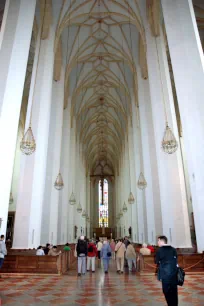
The church was originally designed as a late Gothic church with a long central nave. At the end of the seventeenth century, when the Frauenkirche was the center of the counter reformation in Germany, the interior was decorated with Baroque elements. Most eye-catching were the so-called ‘benno’ arches that spanned the central nave. In the nineteenth century, after the church was promoted to the status of cathedral, all the Baroque elements were removed since at the time Gothic was considered as the only pure church style.
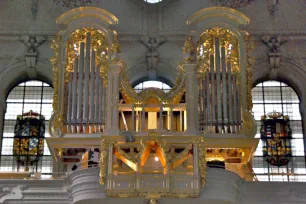
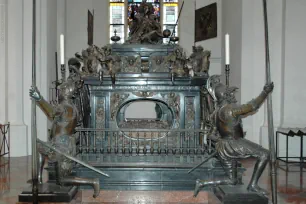
Some of the interior decorations were lost during the air raids of 1944, but there are still many historic works of arts in the cathedral, since most of those objects were brought to a safe location before the air raids took place. Some of the interesting works of art include a painting by Jan Polack from around 1510 and a retable by Friedrich Pacher from 1483.
The choir stalls are decorated with beautiful wooden sculptures by Erasmus Grasser, created around 1502.
There are also a number of modern decorations such as a mosaic by Sepp Frank from 1960 which depicts Pope Pius X. The organ is also recent, it was built in 1994 as part of the interior restoration that took place from 1989 until 1994.
One of the most notable monuments in the church is the tomb of Emperor Ludwig IV of Bavaria (†1347). The black marble sarcophagus is surrounded by statues of four kneeling knights.
The cathedral’s crypt contains the tombs of members of the Wittelsbach family, a powerful dynasty which ruled over Bavaria for centuries.
Footprint of the Devil
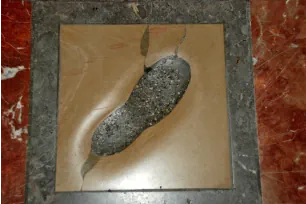
Also inside the church is the ‘footprint of the devil’. According to a legend, the architect of the Frauenkirche, Jörg von Halsbach, promised the devil you could not see a window from the inside of the church. In return, the devil would help him build the Frauenkirche.
After he completed the building, the architect led the devil to the middle of the church from where you could not see a single window, although all churchgoers would sit in an area where a lot of light came through the windows. The devil would have stamped his foot with so much rage that his footprint was visible in the stone floor. The footprint is still clearly visible today.
- Next: Marienplatz
- More Sights & Attractions in Munich
